This was published 5 years ago
Kakadu National Park tour, Australia: Unearthing ancient secrets in Kakadu
By Jim Darby
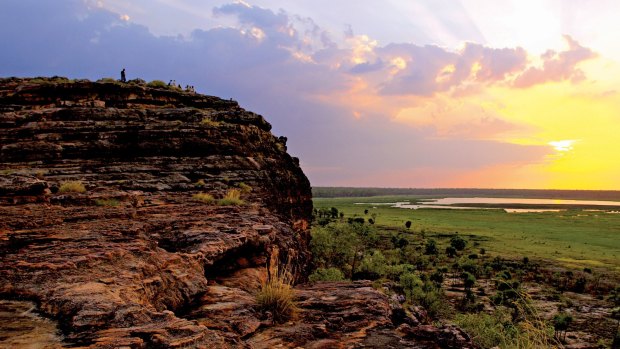
Sunset from Ubirr Rock, Kakadu National Park.
We're riding high in what might just be the offspring of an outback 4WD truck, following its affair with a luxury coach. We'll need the truck's clearance and versatility to cover some rough ground in Kakadu National Park, but so far, on the highway just out of Darwin, we're appreciating the coach's comfortable ride, air-conditioning and, most of all, big picture windows that reveal the big picture of the landscape, its abundant wildlife, its curiosities and its complex cultural heritage. We're on a five-day "Kakadu's Ancient Secrets" tour with Inspiring Journeys. There's a trove of secrets ahead, but first we're going to cool down in the pools fed by the waterfalls of Litchfield National Park.
IN THE SWIM
Sunday morning and it's the Territory's equivalent of a day at the beach, with a United Nations of languages at Litchfield's pools - not surprising given that they're under two hours from Darwin. The crocodile warning signs are being heartily ignored by all. Parks staff manage the crocs and clear the holes after the wet, but they won't guarantee their clearance is perfect. The pool at Wangi Falls is easier to get into than the shower, but of the two, Florence Falls is the more spectacular. It's like swimming in a crater, with huge rock walls framing the pool and the water tumbling out of the forest and over the brink.
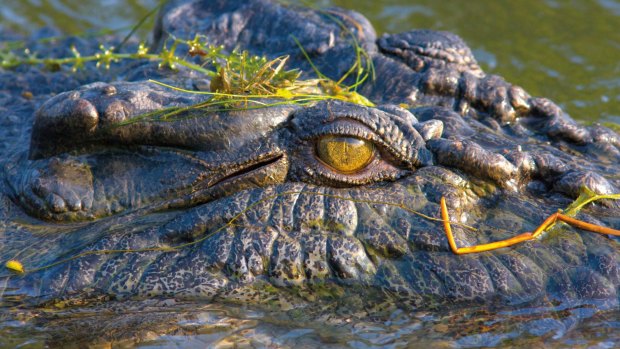
Crocodile spotting.
The first night on tour was at Wildman Wilderness Lodge in the Mary River wetlands area; glamping-style accommodation facing a gravel airstrip. The tents, well-appointed and spacious are made in such a way you can see the stars you're sleeping under and it's a brilliantly-clear night. Cold too, for the Territory (this June night got down to 5C), so all blankets were in play. There's no shortage of wildlife, with agile wallabies leaping about and crocodiles lurking in the billabong down the road.
BEST NOT TO SWIM
Corroboree Billabong is part of the Mary River system which flows to the sea during the wet season, giving the estuarine or saltwater crocodiles (the "salties", yep, the big ones) the ideal environment. There are vast gardens of lilies, with leaves like big green plates, sitting on the water as though you could hop over them all the way to the bank. Not a good move. We'd only been cruising the billabong for 10 minutes and there in the mud was a four-metre saltie, soaking the morning sun and slowly opening an eye to observe us. They're the perfect predator, with massive strength in their jaws and in the spring from their tail and back legs for a lightning-fast attack. Further along, we saw some smaller freshwater crocodiles with their long snouts; the sports cars of the billabong compared with their military-grade saltie cousins.
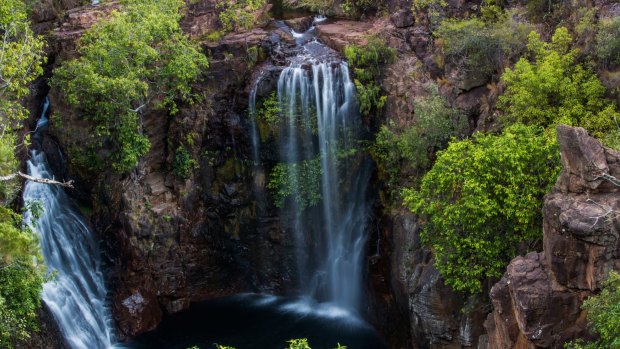
Florence Falls, just over an hour from Darwin, is a favourite day trip for locals and visitors.Credit: Sean Scott
It was alive with birds. A kingfisher darted by and led our eyes to an open bank where a white-bellied sea eagle wrestled with its prey, something that might once have been a white cockatoo. On another bank, a night-heron stood still as a statue on a mangrove branch. They look to the water for their food and the Indigenous people, noting how they seemingly spend so much time looking at their reflection, call them the "love meself long time" bird.
THE GREAT BEYOND
Inside Kakadu, we made our way to Ubirr Rock, to see its art and admire the sun setting over the forests and wetlands; a vast swathe of land with green trees like a canvas of broccoli sweeping into the distance. As the colour in the sky deepened and darkened, I thought I heard clap sticks, the signature Indigenous sound, but it was a boy tapping his Ventolin cannister against its plastic inhaler. I think he was in tune with the moment.

Cicada Lodge is a unique luxury lodge overlooking the Katherine River within the Nitmiluk National Park.
For another perspective I was up early and into Kakadu Air's GA8 Airvan, a steady aircraft with a window seat for all to see Kakadu and West Arnhem Land from above. Arnhem Land covers around 100,000 square kilometres and has a population of about 16,000. Tasmania, by way of comparison, covers 68,400 square kilometres with about 515,000 people. We flew over the wetlands and on towards the fault line that runs through here and throws up a massive ochre wall of a rocky range.
Inhospitable terrain? I wouldn't have thought so. Throw me in here with a billy and a backpack and I'd be in trouble, but alongside some locals willing to share their 60,000 years of understanding of how this country works, how to keep a regular supply of food, water and shelter and how to keep your culture going and I think I might be OK.
THE ART, PART 1
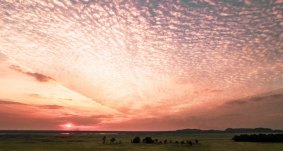
Sunset over the wetlands from Nadab lookout at Ubirr.
Around Ubirr Rock, the rock art is a catalogue of food and recollection - fish, wallabies, goanna and more. On one wall there's what's most likely a thylacine, a Tasmanian Tiger, and they disappeared from mainland Australia around 3000 years ago. In another spot there's a person with shirt and boots, a sign of early contact. Further on in Kakadu, at Burrungkay (or Nourlangie) the art dates back maybe 20,000 years. Our guide and driver Ben Farrington, whose passion for the region is matched by his understanding of its past, explains that "the act of painting is as important as the painting itself. Some of these sites are 'blackboards', used for story-telling or to show food nearby." They also show legends, with paintings here of creation ancestors like Namarrgon, the lightning man, large as life. The next day, we'd become the artists.
THE ART, PART 2
Outside Katherine, on a patch of land that might pass for a hobby farm were it not for the wallabies hopping here and there and the art gallery within, we unloaded to meet Manuel Pamkal and get involved in his Top Didj Experience. Manuel was sitting cross-legged on a table and welcomed us with a blast on his didgeridoo. He's a musician and a painter of the Dalabon people, from Arnhem Land a few hundred kilometres from here. He told of his life and times, of the lack of use they had for a calendar in the bush and the hurdle that created when he once was invited to travel to Japan. Eventually, enough information was gathered to satisfy the passport office and in the document, for his date of birth, it has 00 for the day, 00 for the month and 1966 for the year.
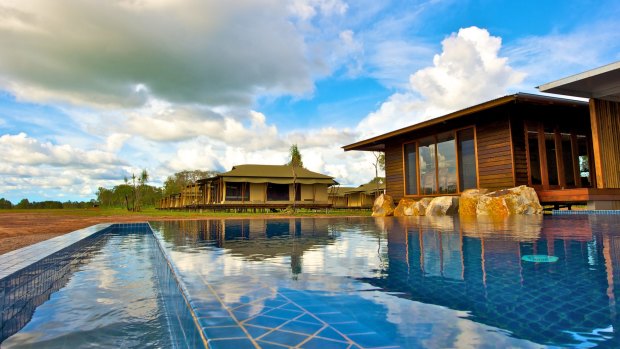
Located in the Mary River National Park Wetlands of the Northern Territory, Wildman Wilderness Lodge is an unforgettable experience.
Manuel and his offsiders took us through the basics of their style of painting. Their art is all about lines; not the dots of the desert. So we painted groups of four white lines as this is the way of the Dalabon; if we'd painted three white lines, we would have belonged somewhere else and, back in the day, would have been punished for the departure from custom. It was an odd sight, a bunch of adults, most of them strangers to it, head down at the art table, making lines and outlines, first with a store-bought brush and then with a reed, sculpted to a fine brush for the detailed strokes. Outside, after our painting lessons, we tried some spear-throwing with a kangaroo cut from plywood as the target. The kangaroo survived.
IN DEEP
Nitmiluk, the name given to this area by the Jawoyn people, means "place of the cicada dreaming"; the place where the spirits of creation reside. Katherine Gorge, as we otherwise know it, is certainly spiritual. We cruised along the river with the walls of the gorge soaring up either side, vegetation spilling out of it wherever it could catch hold, lines of age running through the rock, art applied in seemingly unreachable places.
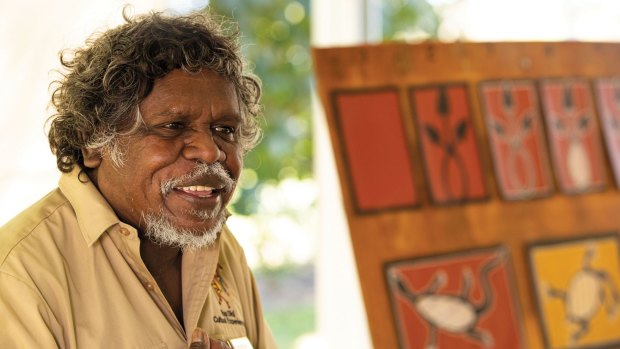
Manuel Pamkal.
We had dinner on the boat, a perfect warm evening with no insects, no wind and the rock walls catching the colours of the setting sun. The chef drove the BBQ up the bow for barramundi or steak and the waitstaff cruised by with wine to buy (yes, the portable pay machine works out here).
Our two nights in this area were at Cicada Lodge, a luxurious eco-style setup with 18 rooms, a cool pool and airey dining and lounge areas. The gorge is just a stroll away and the big rooms face west into the bush for perfect sunset views. The food is excellent and inspired - how about appetisers of a hibiscus and river mint salad and sauteed chilli and garlic crocodile? The other day, at the billabong, it could have been a case of croc-eats-man, tonight at Cicada Lodge, it's man-eats-croc. Delicious.
WILDFIRE TRADITIONS
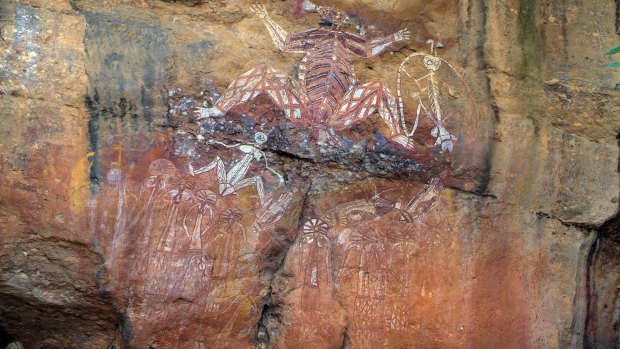
Wall paintings on Nourlangie Rock in Kakadu National Park.Credit: iStock
Amidst one of Australia's worst summers for fire, it's timely to reflect on its management in Kakadu. To reduce the risk of wildfire, park management follow Indigenous burning traditions with fires lit in a mosaic pattern in the cooler months - burn a patch, leave a patch for next season, burn a patch. As we drove past some of these burns, birds - mostly black kites - circled through the smoke to catch the prey flushed out by the flames. They've become so attuned to the practice, they actually help it along. The kites and other birds, the "fire-hawks" have been seen collecting small burning sticks and dropping them in an unburnt area to start a new fire for more of a feed.
TRIP NOTES
TOUR
Inspiring Journeys' Kakadu's Ancient Secrets five-day tour starts from $2995 twin-share, including meals, accommodation and most on-tour experiences. Tours run from April to October ex-Darwin. See inspiringjourneys.com
CRUISE
They say the advantage of Corroboree, over Yellow Water Billabong inside Kakadu, where similar on-water safaris are available, is that Corroboree is 10-times larger and has only two commercial operators, whereas Yellow Water has eight. On the flipside, this tour only operates in the April-October dry season, whereas Yellow Water runs year-round. Our cruise on Corroboree was with Wildlands Wetlands Safari Cruises (see wetlandcruises.com.au) in a purpose-built boat. It was included for us but could easily be done as a standalone adventure out of Darwin; 90 minutes on the boat costs $60 for adults and the 90 minutes went in a blink.
SEE
Scenic flights with Kakadu Air are additional, starting from $150 for a 30-minute flight. See kakaduair.com
STAY
With an early start and late-afternoon conclusion, it's worth bookending the tour with a night or two in Darwin. Mantra on the Esplanade ( bed and breakfast from $210, see mantra.com.au) and Oaks Elan Darwin (room-only, from $140, see oakshotels.com.au) both have central locations for Darwin's CBD and waterfront.
Jim Darby was a guest of Inspiring Journeys.
Sign up for the Traveller Deals newsletter
Get exclusive travel deals delivered straight to your inbox. Sign up now.